Misc
‘Five Nights at Freddy’s’ and The Story of William Afton Explained

If my other articles were individual lectures, this? This is the whole seminar.
Welcome back to Horror 101, a series of articles where we explain horror movie legends and their lore. For beginners, the confused, or just those who need a refresher, these articles are for you.
It’s time you FNAF lovers. Time to rip apart the meaty animatronic lore all over again. Or, if any of this info is wrong, to put me inside a springlock suit for slandering Scott Cawthon’s child. Maybe I misplaced an event, maybe I’ll accidentally call a Toy suit a Funtime suit, who knows. Just don’t murder me yet.
In honor of the fast-approaching Blumhouse adaptation, Five Nights at Freddy’s, we’ll get down to the heart of horror gaming’s most popular franchise and find the man behind the slaughter. How are these animatronics killing people, and more importantly, why are they killing people? Who started it all?
Five Nights at Freddy’s is probably the most complicated series I’ve ever covered, as a lot of the fun of FNAF is deciphering its storytelling. As such, I need to establish some boundaries so this article doesn’t become a hot mess.
I’m not going to be discussing any non-game materials, including graphic novels, guides, and books like The Silver Eyes because of their dubious canonicity.
- I’m also not including any speculation that isn’t given clear backing by the events of the games. I don’t have Mat Pat’s mental fortitude.
- I’m not covering any games past the sixth and seventh (Freddy Fazbear’s Pizzeria Simulator & Ultimate Custom Night) because, while Steel Wool’s games are connected to the original story, they don’t concern the main subject of this article.
All good? Wonderful! Let’s get started.
Without further ado, major spoilers for the first seven Five Nights at Freddy’s games.

Who Is William Afton in Five Nights at Freddy’s?
The story of Five Nights at Freddy’s begins with the unassuming William Afton, also known as Purple Guy because of how his sprite is presented in the games. Starting as an entrepreneur and mild-mannered family man, Afton would become one of the most notorious serial killers of his time.
He had a wife and three children: Michael, Elizabeth, and Michael’s unnamed younger brother (dubbed the Crying Child by fans).
Afton founded Fredbear’s Family Diner, a precursor to Freddy Fazbear’s Pizza. Like the real-life Chuck E. Cheese and Showbiz Pizza restaurants, the main selling point of Fredbear’s was its costume mascots: Fredbear and Bonnie the Bunny. Despite Fredbear being the face of the company, Afton would later use the Bonnie suit most frequently in his murders and would suffer greatly for his fondness of the character.
Matthew Lillard, known for portraying the unforgettable Stu Macher in Scream, will play William Afton in the film. While it isn’t confirmed, a lot of fans suspect that Josh Hutcherson’s character Mike Schmidt (who you play as in the first Five Nights at Freddy’s game) is an alias of William’s eldest son, Michael Afton.
Who Created the Five Nights at Freddy’s Animatronics?
Afton came to collaborate with a man named Henry Emily. A robotics expert who taught Afton the trade, Emily took Afton’s suits and developed full-fledged animatronics from them that could even walk independently. Henry Emily doesn’t have a confirmed casting for the film, but actor Christian Stokes will be playing the role of “Hank”. Some fans suspect this could be Henry given the nickname.
Emily and Afton came up with multiple makes and models of animatronics, though their most remarkable versions were springlock suits: suits that could be converted into free-standing animatronics and back again. The springlocks were eventually revealed to have one glaring mechanical failure: sudden movements could cause the suits to lock up and seize around any person or thing inside them, often paralyzing and horribly injuring them. The glaring flaw would put springlock suits at the center of a tragedy known as the Bite of ’83.
What Was the Bite of ’83 in Five Nights at Freddy’s?
I remember back in my day we all thought it was the Bite of ’87.
Man, I feel old.
…RIGHT. SO, WHAT WAS THE BITE OF ’83?
Sorry.
In 1983, Michael was forced to babysit his brother during a birthday party at Fredbear’s. As part of a mean-spirited prank, he and his friends pushed his younger brother’s head into the open mouth of the Fredbear animatronic. The springlock suit’s mechanisms seized up from the child’s panicked flailing, “biting” his skull. He would die days later after being haunted by nightmares of the animatronics, as shown in Five Nights at Freddy’s 4.
A grieving Afton succumbed to madness and committed his first murder: the daughter of his business partner Henry Emily, outside of the Fredbear’s Family Diner location. These two events resulted in the closure of Fredbear’s Family Diner and the retirement of both suits on stage at the time of the incident, the golden Fredbear and golden Bonnie springlock suits.
Afton and Emily tried to move on, pouring their resources into a new venue: Freddy Fazbear’s Pizza, complete with a new cast of animatronics headlined by Freddy Fazbear, a new blue version of Bonnie the Bunny, Foxy the Pirate Fox, and Chica the Chicken. These are the mainstay suits we’ll be seeing in the movie, and the ones most of the other animatronics are based on.
Of course, Afton’s bloodlust wouldn’t stop there. He slowly began to give in to his sadistic cravings, killing five more victims and hiding their bodies inside each of the animatronic suits (including the retired Golden Freddy suit). He used the springlock Bonnie suit when committing these murders, and while Afton was among the suspects, the missing cases were never solved. Emily still suspected his business partner of the crimes and ousted Afton from the company.

How Are the Five Nights at Freddy’s Animatronics Haunted?
Though nobody knew at the time, the agony of the victims allowed their souls to be bonded to the metal, creating a substance known as “Remnant”. This process caused the confused and tortured souls to become vengeful and murderous, targeting the night security of the restaurant (who you play as in the first Five Nights at Freddy’s).
Remnant could even trap souls in their original bodies. A grown Michael Afton would later discover his father’s machines, only to be killed and briefly worn as a “suit” by another animatronic. The Remnant injected in him during this event allowed Michael’s broken body to rise from the dead, clinging to life from an obsession with finding and stopping his father.
Both Afton and Emily would continue making animatronics, all of which met the same fate. Afton created a rival mascot with more advanced technology called Circus Baby, which would malfunction and kill his daughter Elizabeth, causing her to haunt the suit. Henry Emily would then go on to reopen Freddy Fazbear’s Pizzeria years later in 1987, with new “Toy Animatronics”: updated versions of the old cast wired to protect children and detect predators with facial recognition.
How Did William Afton Die in Five Nights at Freddy’s?
Afton’s second spree began in 1987 with the sabotage of the pizzeria’s grand reopening. Tainting the new Toy Animatronics with another series of killings, they became especially aggressive towards adults (as seen in Five Nights at Freddy’s 2, for those of you keeping track at home). This resulted in another shutdown, and the toy animatronics being decommissioned.
Eventually, Afton came across the original animatronics he had used to hide the bodies moving without being activated. After dismantling them one by one, in either an attempt to hide his crimes or understand their inner workings, he discovered the secret of Remnant.
On one of his many returns to the crime scene, Afton was cornered by the children’s spirits in a hidden backroom of the original pizzeria. Hoping the springlock Bonnie suit would instill the same fear in them in death as it had in life, he donned the worn-down costume. A total springlock failure from his frantic movements caused the suit to clamp down around him, crushing him to death.
Who Is Springtrap?
When Emily discovered his old business partner’s body, he sealed the room off and left Afton’s remains to rot. Like the children before him, Afton’s spirit became tangled with the metal of the Bonnie suit, creating Remnant and tying him to the material world. This transformation would see Afton reborn in the monster known as Springtrap.
The rotted-out Springtrap would be unearthed years later during the events of Five Nights at Freddy’s 3. The pizzeria was repurposed for a horror attraction called Fazbear’s Fright; a sort of extreme haunt focused on the “urban legends” surrounding the murders. When Michael Afton took a job as the attraction’s security and discovered his father was still alive through the suit, he burned down Fazbear’s Fright in a failed effort to kill Springtrap.
One of the featured suits in the film’s trailer was a tattered Golden Bonnie suit, the same one that Afton died in around the events of Five Nights at Freddy’s 2. Whether Afton is already dead in the film is uncertain, but I would be surprised if he was since the suit in the game is much more decayed than what we’ve seen. They’ll probably save his resurrection for the second and third movies.
Neither of which have been confirmed, but… come on. We both know they’re happening.

How Were the Five Nights at Freddy’s Animatronics Destroyed?
Emily and Afton became embroiled in a game of cat and mouse following the burning of Fazbear’s Fright. Through Emily’s research on Remnant, he found it could be destroyed by melting; he then constructed a labyrinth, a mock restaurant that would draw any remaining animatronics that hadn’t been scrapped. Finally, he hired a security guard as bait: an undead Michael Afton, looking to stop his father.
Henry Emily, Michael Afton, and William Afton would perish alongside each other with all the other animatronics brought to the maze. The fire set this time would destroy nearly every trace of the murders and their culprit; with their killer vanquished and their animatronic vessels destroyed, the children’s spirits were freed. In the game Ultimate Custom Night, Afton’s soul is shown condemned to a hell that repeats the events of the games forever and forces him to face his most violent creations on a loop, screaming for Michael’s help.
Afton’s creations would live on though, with Fazbear Entertainment being bought up and revived by a third party… which I’m not talking about today! But almost definitely in a future article, dear reader.
FNAF comes back. It always comes back.
***
And that will be it for today’s Horror 101 lesson. See you in the next class and stay tuned to Horror Press’s social media feeds for more content on horror movies, television, and everything in between!
Misc
Our Halloween Giveaway Is Here!

Enter Our Halloween Giveaway!
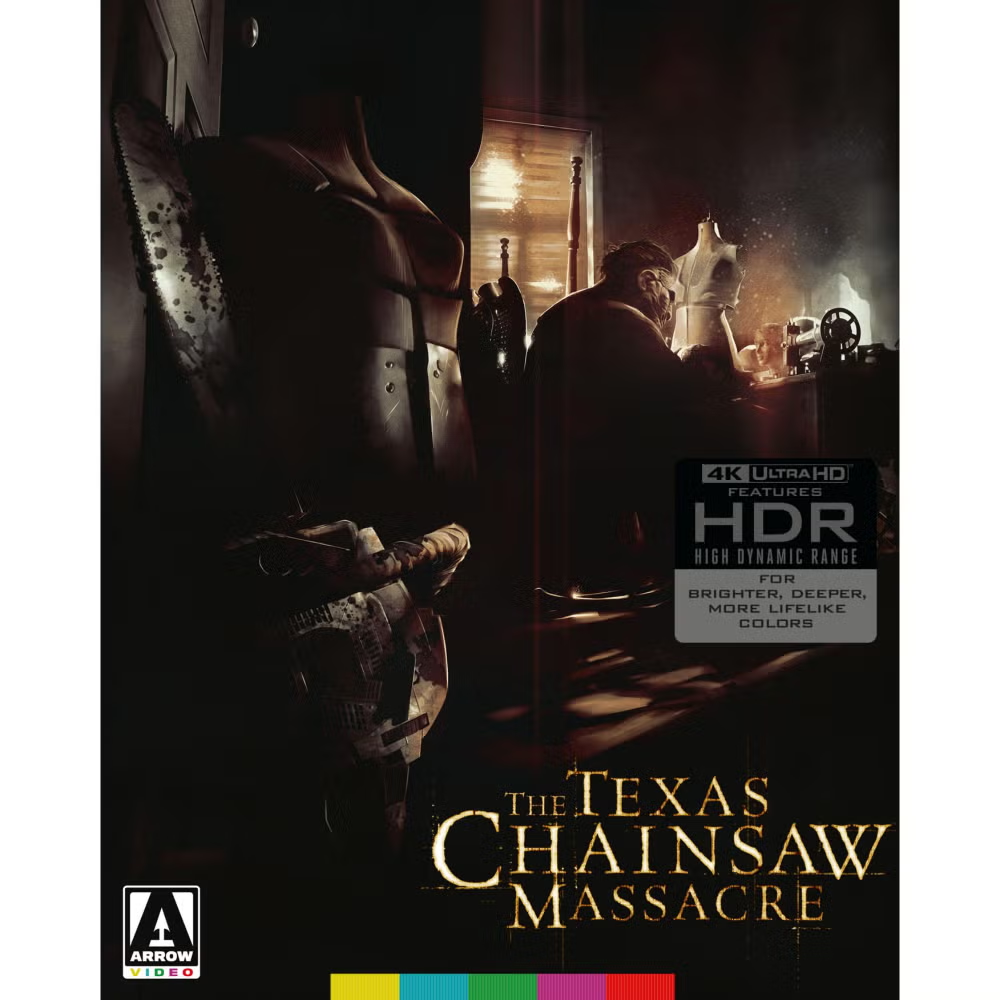
How to Enter:
Step 1. Make sure to FOLLOW US ON FACEBOOK AND JOIN OUR FACEBOOK GROUP!
Step 2. LIKE AND SHARE the giveaway post!
Step 3. This is the most important step, email us at contact@horrorpress.com with your FULL Facebook name (so we can verify you’re in the group) and who your favorite character is from the Texas Chainsaw franchise.
**Giveaway entries are limited to addresses in the United States.**
**All entries must be 18 or older to enter**
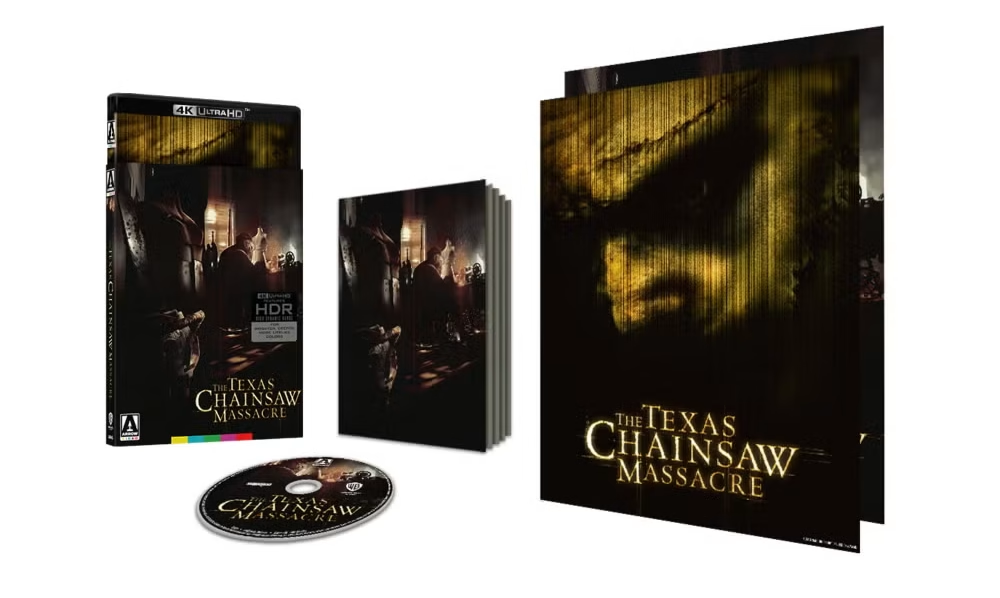
What You’ll Win
The Texas Chainsaw Massacre (2003) Limited Edition 4K UHD from Arrow Video
- 4K (2160p) Ultra HD Blu-ray presentation in Dolby Vision (HDR10 compatible)
- Original DTS-HD MA 7.1 and 5.1 surround audio and lossless stereo audio
- Optional English subtitles for the deaf and hard of hearing
- Brand new audio commentary with Dread Central co-founder Steve “Uncle Creepy” Barton and co-host of The Spooky Picture Show podcast Chris MacGibbon
- Archival audio commentary with director Marcus Nispel, producer Michael Bay, executive producers Brad Fuller and Andrew Form and New Line Cinema founder Robert Shaye
- Archival audio commentary with Marcus Nispel, director of photography Daniel Pearl, production designer Greg Blair, art director Scott Gallager, sound supervisor Trevor Jolly and composer Steve Jablonsky
- Archival audio commentary with Marcus Nispel, Michael Bay, writer Scott Kosar, Brad Fuller, Andrew Form and actors Jessica Biel, Erica Leerhsen, Eric Balfour Jonathan Tucker, Mike Vogel and Andrew Bryniarski
- Reimagining a Classic, a brand new interview with director Marcus Nispel
- Shadows of Yesteryear, a brand new interview with cinematographer Daniel Pearl
- The Lost Leatherface, a brand new interview with actor Brett Wagner
- Masks and Massacres, a brand new interview with makeup effects artist Scott Stoddard
- Chainsaw Symphony, a brand new interview with composer Steve Jablonsky
- Chainsaw Redux: Making A Massacre, a making-of documentary
- Ed Gein: The Ghoul of Plainfield, an in-depth look at the infamous killer who inspired the character of Leatherface
- Severed Parts, a look at the cutting room floor and some of the scenes excised from the final edit
- Deleted scenes including an alternate opening and ending
- Screen tests for Jessica Biel, Eric Balfour and Erica Leerhsen
- Behind-the-scenes featurette
- Cast and crew interviews
- Theatrical trailers and TV spots
- Concept art galleries
- Reversible sleeve featuring original and newly commissioned artwork by Aaron Lea
- Double-sided foldout poster featuring original and newly commissioned artwork by Aaron Lea
- Illustrated collector’s booklet featuring new writing on the film by Michael Gingold
Misc
NYCC 2025 Horror Highlights: A Sneak Peek at ‘The Lost Boys’ Musical, ‘Resident Evil: Requiem,’ and More!
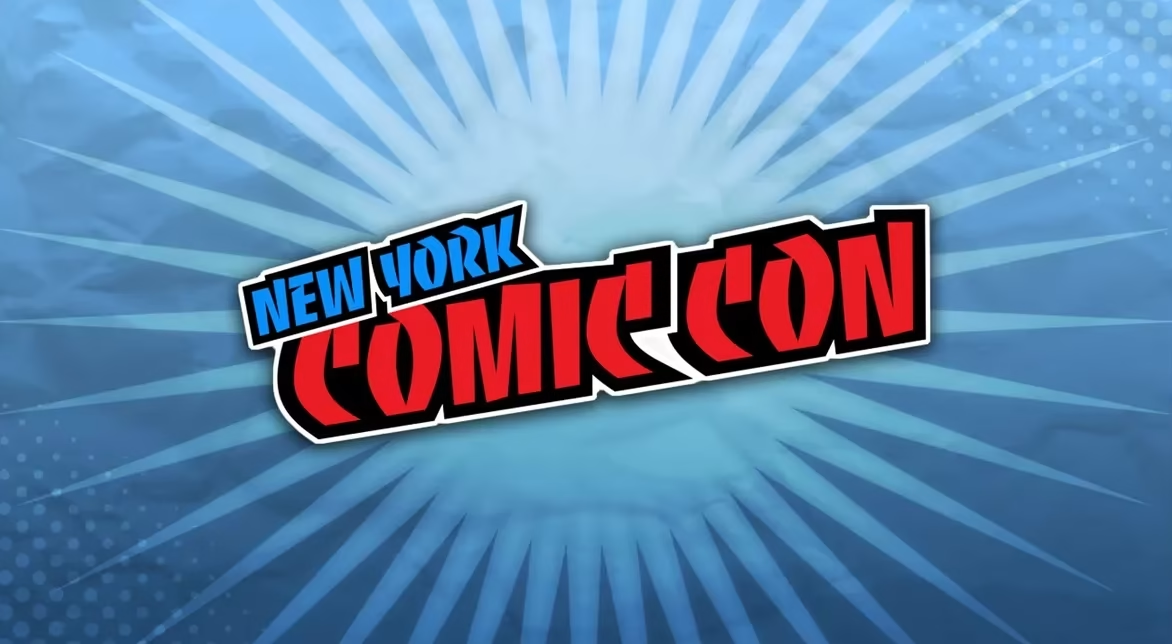
As soon as New York Comic Con announced that its 2025 theme would be “haunted,” I started lacing up my comfy shoes and making a beeline for the Javitz Center! Horror has always been represented at the con, but it felt fitting that it should play a central role in this year’s event at a time when the genre seems more popular than ever.
From beloved family-friendly properties like The Nightmare Before Christmas to pants-dampening titles like the upcoming Resident Evil: Requiem, horror appeared in countless shapes and forms. Here are all the best and scariest insights I gleaned from the show floor, panel rooms, and pop-ups of New York Comic Con 2025!
Our NYCC 2025 Horror Highlights
Resident Evil: Requiem Is Going to Test Your Bladder Strength
Full disclaimer: I’m not a gamer. I’m honestly pretty bad at games, which made my Resident Evil: Requiem play session all the more frightening because I was convinced that everyone around me would realize I’m a fraud. But with easy-to-grasp controls, even for a newb like me, the latest installment in the iconic horror franchise quickly sucked me in and left me on edge for entirely different reasons.
During my 30-minute session, I was introduced to FBI analyst Grace Ashcroft, Requiem’s central character. She swims to consciousness to find herself strapped upside down on a gurney with a needle in her arm, siphoning her blood. After Grace managed to free herself, the controls were handed over to me to explore the creepy facility through Grace’s eyes, looking for a fuse. Some spaces were bathed in red light; others were lit only by flickering bulbs that left me white-knuckling the controller, waiting for something to emerge from the shadows and swallow me whole, not helped by Grace’s anxious, stuttering breathing in my ear.
I took a moment to appreciate how detailed video games have become since my childhood experiences playing Evil Dead: Hail to the King on the original PlayStation (seriously, you can see the dust drifting in beams of light now?!), only for the sound of movement somewhere in the facility to yank me back to the present. I renewed my frantic search for the fuse, only to run blindly into a pitch-black room and encounter something enormous that dragged me into the darkness. Sorry, Grace!
You can find out what happens next when Resident Evil: Requiem releases for the PlayStation 5, Xbox Series X|S, PC, and Nintendo Switch 2 on February 27, 2026.
Megan Fox Is Among the New Cast Members in Five Nights at Freddy’s 2—And Blumhouse Hasn’t Given Up on Its Other m3gan Yet
Blumhouse made several announcements at their NYCC panel, most notably that Megan Fox (Jennifer’s Body) is voicing Toy Chica in director Emma Tammi’s highly anticipated sequel Five Nights at Freddy’s 2, coming to theaters on December 5. Other new additions to the cast include YouTuber Matthew Patrick, aka MatPat, who cameoed in the first movie and will voice Toy Bonnie, and Kellen Goff, who has voiced multiple characters in the game series and will now lend his pipes to Toy Freddy.
I’m interested in Five Nights at Freddy’s 2, not least because my best friend is terrified of the franchise and makes a wildly entertaining moviegoing companion—but I’m more interested in the future of another Blumhouse franchise, M3GAN. After the sequel underperformed, likely due in part to its hard genre pivot away from horror and into action territory, the future of the killer doll is uncertain. But in a special industry presentation on “The Business of Fear,” Jason Blum revealed that “we’re all working to keep M3GAN alive,” adding that Blumhouse is exploring other potential mediums before trying to resurrect her on film.
Does that mean a M3GAN video game might come our way in the future, or perhaps a TV series? I don’t know, but I have a feeling this isn’t the last we’ve seen of the silicone diva.
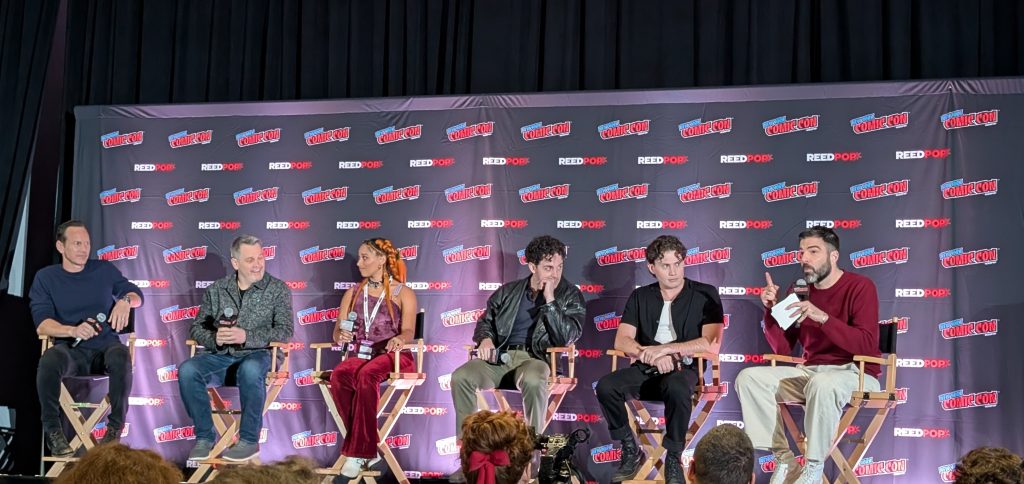
Photo taken by Samantha McLaren.
The Lost Boys: A New Musical Will Feature Flying Stunts and a Live Vampire Band
My queer heart is a sucker for musical adaptations of horror films I love, so you can be certain that I’ll be heading down to the Santa Carla Boulevard—aka Broadway’s Palace Theater—for The Lost Boys: A New Musical, which begins previews on March 27, 2026. At their NYCC panel, producer Patrick Wilson (The Conjuring franchise), director Michael Arden (Maybe Happy Ending), and cast members LJ Benet, Ali Louis Bourzgui, and Maria Wirries revealed why they feel Joel Schumacher’s 1987 classic translates so well to the stage, and what audiences can look forward to.
“There’s something that I see with both horror movies, musicals, and superhero movies—there’s an element of melodrama that’s really rewarding,” says Wilson, who began his career in musical theater and worked with Schumacher on the director’s 2004 film adaptation of The Phantom of the Opera. “Some people view it as camp, but there’s a reality of it being heightened that felt like this story cemented itself so much to being a musical.”
“They’re a biker gang, after all, and there’s a level of theatricality to that in and of itself,” says Arden. “Our biker gang also happens to play instruments.”
That’s right: the vampires will be playing instruments live on stage, which made casting twice as hard. Ali Louis Bourzgui, who plays David, the character portrayed by Kiefer Sutherland in the film, reveals that he plays guitar. And that wasn’t the only unusual request in the casting call: auditions included a flying test. (Presumably wires were involved, unless Arden has found himself a real cabal of vampires in his cast.)
Other highlights that fans can look forward to include killer music from one of Arden’s favorite bands, The Rescues. You can listen to the song “Have to Have You” right now, featuring instrumentals from Slash. The director also teases that many fan-favorite moments from the film will feature in some way in the musical, including the bridge scene and, yes, even the sexy saxophone guy.
Greg Nicotero’s Guts & Glory Marks a New Challenge for a Legend of the Business
If you like looking at gnarly practical effects in horror movies, chances are you’re familiar with Greg Nicotero’s work, whether you realize it or not. The legendary SFX artist has worked on everything from George Romero’s Day of the Dead and Sam Raimi’s Evil Dead II to Kill Bill and, more recently, The Walking Dead. The impressive extent of his resume was made clear at the panel “Shudder is Here to Scare the S*** Out of You,” in which almost any film mentioned by the other panelists was met by a small smile and a humble murmur of “worked on that” into the mic, often followed by a wild anecdote. Nicotero seems like the most interesting man in the world to grab a drink with, and his new horror competition show for Shudder—Guts & Glory—will let us see more of the man behind the makeup brush.
“Guts & Glory is one of the most fun times I’ve had on a show,” Nicotero says, teasing that the series is “part Sam Raimi, part Halloween Horror Nights, and part Survivor.”
In the six-episode first season, contestants are dropped into an Alabama swamp, where there’s an urban legend about an evil spirit. “One of the contestants gets possessed by the evil spirit, people start dying off, but in the meantime, they’re still competing and there’s a prize,” Nicotero explains.
Guts & Glory is effects-heavy, which was challenging to do in an unscripted series relying on real people’s real-time reactions. “You do a movie, you can cut and try it again,” Nicotero explains. “[This] was completely out of my wheelhouse and out of my comfort zone, but I’m really, really proud of it.”
Nicotero’s Creepshow was one of the first original shows to debut on Shudder, so he’s truly part of the DNA of the horror streamer, which celebrated its 10th anniversary this year. Guts & Glory premieres on October 14 as part of Shudder’s Season of Screams programming.
Horror Short The Littles Deserves the Big-Screen Feature Treatment
Some short films are perfectly suited to their bite-sized format, while others contain the seeds of something much bigger. At the New York Premiere of The Littles, a new short written and directed by American Horror Story producer Andrew Duplessie, I could immediately see the potential for the feature film that Duplessie hopes to make.
Equal parts charming and unsettling, The Littles stars M3GAN’s Violet McGraw as a little girl with a loose floorboard in her bedroom. One night, a scuffling sound and a crack of light between the boards lead the little girl to discover that her family isn’t alone in the house…
Duplessie says The Littles was inspired by his own experiences growing up in a creaky old house with a no-doubt overactive imagination. The short features creepy-cute stop-motion animation from Anthony Scott (The Nightmare Before Christmas), puppets by Katy Strutz (Guillermo del Toro’s Pinocchio), and some truly adorable miniature sets by Aiden Creates, all blended perfectly with the live-action scenes. Check it out if it’s playing at a festival near you, and watch this space for a (fingers-crossed) future feature!
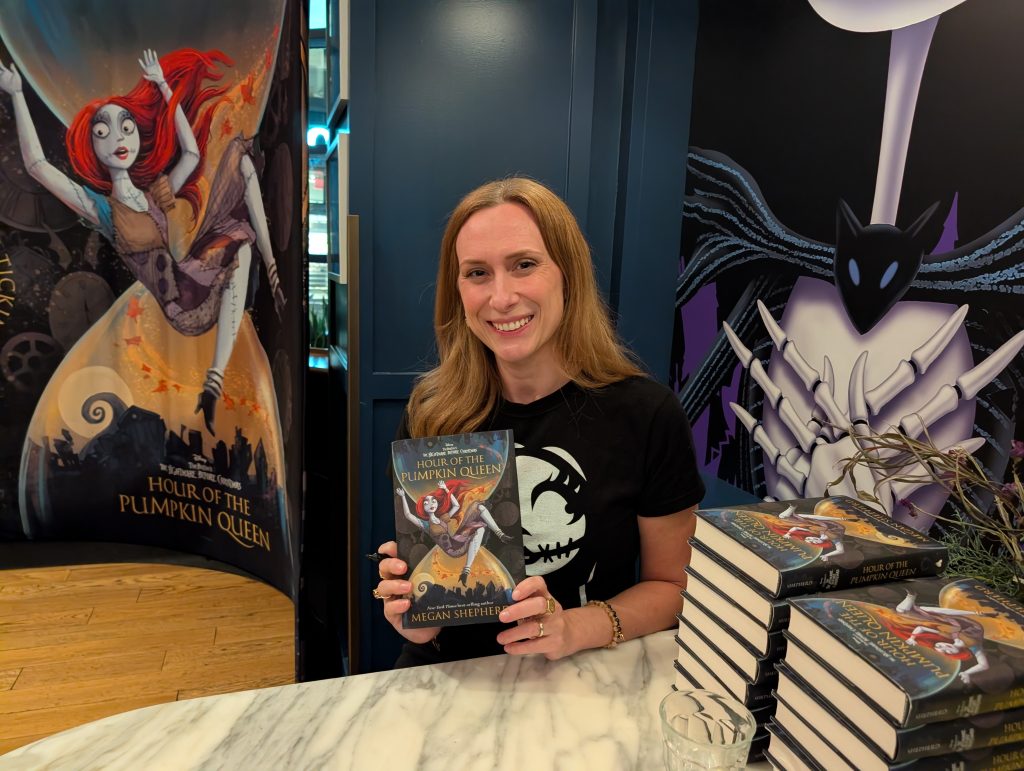
Photo taken by Samantha McLaren.
Disney Publishing’s New The Nightmare Before Christmas Tie-in Novel Welcomes Younger Fans into the Scary Fun
NYCC’s horror happenings weren’t all geared toward an adult audience. Disney Publishing took over Daily Provisions Manhattan West for a pop-up experience inspired by The Nightmare Before Christmas, featuring themed food and drinks like a delectable Pumpkin Potion coffee that I could honestly drink all season long.
At a media and creator event in the space, I took a look at the newly released Hour of the Pumpkin Queen from New York Times best-selling author Megan Shepherd, who also wrote the official novelization of The Nightmare Before Christmas for the film’s 30th anniversary in 2023. In this new tie-in novel, Sally and her rag doll apprentice, Luna, embark on a time-bending adventure to save Jack Skellington and Halloween Town after falling through a mysterious portal.
I was gifted a copy of the book by Disney, but all opinions are my own here. I’m looking forward to giving it a read during the inevitable Halloween hangover that takes place in November, before likely passing it on to my young nieces when they’re old enough. It’s a full novel, not a picture book, so definitely geared more toward a YA audience, but between the beautiful artwork on the cover and the seasonal theme, it might just be the perfect gift for the budding horror lover in your life.
That’s a wrap on New York Comic Con 2025! Be sure to bookmark Horror Press if you haven’t already so you never miss our coverage of conventions, festivals, and more.


























